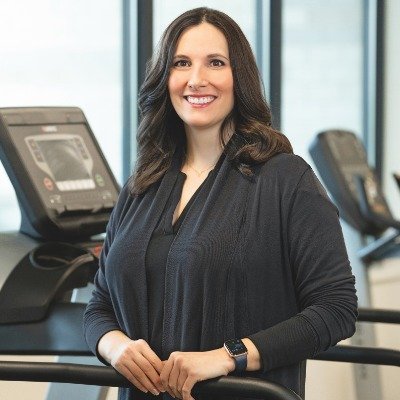St. Clair Health Physical Therapy Helps Patients Make the Long Journey to Recovery
By Andrew Wilson
Lauren Cerqua – Manager of Therapy Services at St. Clair Health
Recovering from an injury or surgery is a journey that may seem impossible at times, but a good physical therapy program can make that journey possible.
“Most patients come to physical therapy with some degree of anxiety, frustrations, and pain,” said Lauren Cerqua, manager of Therapy Services at St. Clair Health. “We reassure patients that PT is here to help you recover.”
Recovery is a process. It doesn’t happen immediately, and even when a patient understands that it takes time, there may still be frustrations that they aren’t recovering faster.
“The healing process is never a straight line,” said Cerqua. “It really depends on what is happening with that patient. There may be major gains on some days, but other days the gains will be less.”
She also emphasizes that two people may have had the same surgery or suffered the same injury, but their rehabilitation journey will be different for various reasons.
“We’ve had patients who have had a knee replaced and they mention that a friend of theirs also had a knee replaced but maybe had some difficulty, and they want to know if that is going to happen to them, too,” Cerqua said. “The answer is not necessarily. Everyone’s recovery is different.”
In physical therapy, the first step – once a patient has been referred by their doctor – is to evaluate the patient, the injury, and the goals they have for themselves.
“We ask questions,” Cerqua said, adding that an individualized plan is created based on the patient’s goals and answers to the questions the therapist asks. “We ask what the hardest thing for them to do is right now. We focus on daily living and what activities are most important to them. The patient drives the goals.”
Some people’s goals are modest, while others set ambitious goals for themselves. Cerqua says the plan is adapted to each patient.
“We meet them wherever they are and determine how best to achieve the goals,” she says. “Sometimes that means setting smaller short-term goals for them to achieve while keeping their long-term goal in focus.”
Pain is one of the aspects that has to be managed in physical therapy. There’s an old cliché in exercise and particularly competitive weightlifting that goes, “No pain, no gain.” For the average person, that’s an oversimplification at best and terribly misleading at its worst.
“Pain is so individualized,” said Cerqua, explaining that different people have varying pain tolerance, too. “A little bit of pain is okay, but a lot of pain is not okay. In PT, we are re-educating the nervous system that it is okay to move that knee again, and the nervous system is responding. That re-education comes along with some pain.”
After the day’s PT session is complete, the patient is given some exercises to do while at home. Following through on those exercises away from the PT facility is important – but even this can be overdone if not careful.
“Some people need encouragement, but others are so eager to get back to normal activity that they overexercise,” Cerqua said. “We may want them to do the exercise routine we give them once or twice a day, but they do their exercises five times a day When they come to therapy, their muscles are inflamed, and we have to treat that.”
Cerqua says that therapists cover three concepts with patients when establishing an exercise routine:
Why they are doing the exercise program
How the exercises will help their recovery
How it will help them meet their long-term goals
“Our goal is to keep patients motivated and keep them positive,” she said, adding that the age of the patient is not as important as attitude and activity. “It really depends on the person. We’ve had elderly patients who move better than some middle-aged people. The level of activity that someone is used to is important.”
When it comes to activity, it doesn’t have to be complex either. Cerqua says fitness begins with putting one foot in front of the other.
“People who walk on a regular basis do best in physical therapy,” she said, adding that 10,000 steps a day may not be possible for some, but that’s okay. “Even 4,000 to 5,000 steps a day is better than being sedentary.”
St. Clair Health’s Outpatient Rehabilitation Services offer a full spectrum of physical, occupational, and speech therapy services. The highly experienced staff provides treatment for a wide variety of diagnoses that may be limiting activities of daily function and strives to provide every patient with comprehensive care in a compassionate environment. Services are offered at the following locations:
Dunlap Family Outpatient Center
1000 Bower Hill Rd, Suite 5300
Pittsburgh, PA 15243
(412) 942-4060
Village Square Outpatient Center
2000 Oxford Drive
Bethel Park, PA 15102
(412) 942-7122

